

Inside OKCupid: The math of online dating - Christian Rudder. Unlocking fractals: An exercise in pure mathematics. “This shape here just came out of an exercise in pure mathematics.
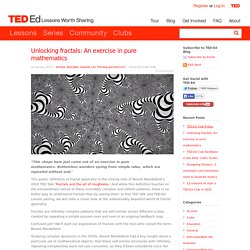
Bottomless wonders spring from simple rules, which are repeated without end.’ This poetic definition of fractal geometry is the closing note of Benoit Mandelbrot’s 2010 TED Talk ‘Fractals and the art of roughness.’ And while this definition touches on the extraordinary nature of these incredibly complex and infinite patterns, there is no better way to understand fractals than by seeing them. How to teach a young introvert. Susan Cain sticks up for the introverts of the world.

In the U.S., where one third to one half the population identifies as introverts, that means sticking up for a lot of people. Some of them might be data engineers overwhelmed by the noise of an open-floor-plan office. Others might be lawyers turning 30, whose friends shame them for not wanting a big birthday bash. Why we love repetition in music - Elizabeth Hellmuth Margulis. The science of setting goals. It’s the time of year when optimism strikes anew and we think to ourselves: our New Year’s resolutions will totally work out this time.

Never mind that we abandoned them by Valentine’s Day last year. And the year before. And, well, you know the drill. The Atlantic slave trade: What too few textbooks told you - Anthony Hazard. The Atlantic slave trade sent slaves to various locations in the world.
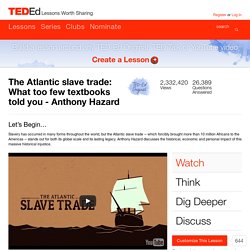
What effect did this forced migration have on these areas? Visit the Mariner’s Museum Captive Passage website. Gain some more perspective on how the slave trade affected the Americas. Then read the transcript or listen to this 15 Minute History podcast and find out more. The great conspiracy against Julius Caesar - Kathryn Tempest. Non-textual sources can also help us understand Marcus Brutus better.
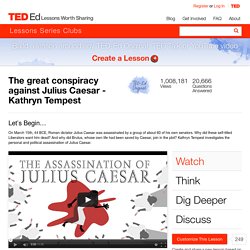
Coins in particular enable us to see how Brutus presented his political agenda at the time. Music and math: The genius of Beethoven - Natalya St. Clair. Natalya would like to acknowledge the amazing support of her friends Wendy Cho, Carolyn Meldgin, Antoinette Evans, Will McFaul, Aaron Williams, and her fantastic students and colleagues at Countryside School and Math Zoom, especially Chris Antonsen, Kim File, Harold Reiter, Jeffrey Huang, Kashyap Joshi, and Priscilla Wang.
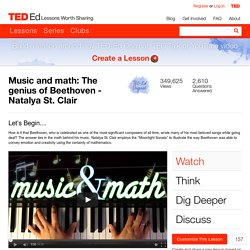
Frequency and Music Our abilities to recognize patterns in music using sine waves help to “see” innovative ways of problem-solving. For teachers, a great introduction to teaching frequency theory can be found here ( Students might enjoy discussing the activity found in NCTM Illuminations to explore more with the mathematics of music. Sound travels through energy in the form of wavelengths, which can be described using the function of the form f(x) = A sin (B x). For a nice overview of sine waves, watch The Math of Music. Frequency theory has many interesting and unique properties, some of which lead to harmonic analysis in upper-level math classes.
Should all students learn a second language? One TED-Ed Club member advocates... Yash Khatavkar, Fridley High School TED-Ed Club Member and high school senior, wants to see a change in the way schools approach language instruction.

As a child who wanted to learn Spanish, Yash took issue with the fact that his elementary school only offered one hour of Spanish instruction per week. In his final TED-Ed Club presentation, Yash explores the positive benefits of multilingualism, and advocates for earlier and better language instruction in schools. What was your TED-Ed Club presentation about? My presentation was about language. The pharaoh that wouldn't be forgotten - Kate Narev.
A female who is considered one of Egypt’s most forward thinking pharaohs?
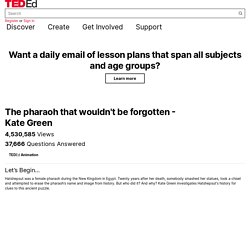
Hatshepsut was just that woman. Read here how Egypt grew and was at peace during her years of rule. Hatshepsut actually took on many of the duties similar to the king of Egypt during her reign. Read National Geographic’s story, The King Herself and discover more about her lineage, accomplishments, and struggles. Why might people believe there was an attempt to erase her from the history of Egypt? Was there a darker side to Hatshepsut that no one suspected?
At what moment are you dead? - Randall Hayes. How teachers can best use TED Talks in class. What happens when a teacher mixes Madame Bovary and a TED Talk?

Good things, actually. Photo: iStockphoto By Olivia Cucinotta My high school English class had just finished reading Madame Bovary, and we were all confused. A brief history of melancholy - Courtney Stephens. Robert Burton attempted to gather the totality of human thinking on sadness and melancholy in his 1621 book The Anatomy of Melancholy.
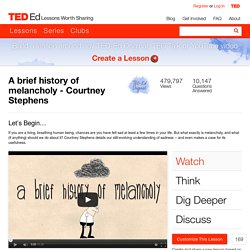
Similar to the approach in this video, Burton gathered widely in thinking about the subject. This includes quotes from thinkers and literature, anatomical drawings, and Burton’s own meditations. Check this page of quotes by Robert Burton for more insight into his thinking! Burton was fascinated by the ancient humoral medical system, from which the word melancholy is derived: Black bile = melancholia. Quantum mechanics 101: Demystifying tough physics in 4 easy lessons. Ready to level up your working knowledge of quantum mechanics? Check out these four TED-Ed Lessons written by Chad Orzel, Associate Professor in the Department of Physics and Astronomy at Union College and author of How to Teach Quantum Physics to Your Dog. 1. Particles and waves: The central mystery of quantum mechanics One of the most amazing facts in physics is that everything in the universe, from light to electrons to atoms, behaves like both a particle and a wave at the same time.
The 2,400-year search for the atom - Theresa Doud. Ernest Rutherford Although Ernest Rutherford is well known for his discovery of the nucleus, he did a lot of other research and experiments into topics other than the atom. He started his career studying electricity and magnetism and it wasn’t until he left his home of New Zealand and moved to Cambridge, England that he started working with the atom.
Working under J.J. Thomson at Cambridge University, Rutherford investigated electrical conduction in gases using X-rays. Ed launches an interactive periodic table with a video for every element. In 1864, Dimitri Mendeleev published the first periodic table that organized all the known elements in the world. This tool was groundbreaking for many reasons–including the fact that Mendeleev planned with incredible foresight, leaving space for any new elements that would be discovered beyond his time.
The history of the periodic table is fascinating, but If you’ve ever taken a chemistry class, you know that memorizing those elements and understanding their properties can be difficult! To help provide a refresher and a study aid of sorts, TED-Ed collaborated with Brady Haran, best known for his YouTube channel Numberphile and his extensive video coverage of the periodic table, to create a clickable periodic table with videos on every element. CLICK HERE to visit the table and find out fun facts on all your favorite elements, from Hydrogen to Ununennium and beyond.
Getting started as a DJ: Mixing, mashups and digital turntables - Cole Plante. Film guru gives students tips on filming presentations. When TED first started, the conference consisted of a small group of people sharing ideas in a theater in Monterey, California. And in those early years, that’s basically where the ideas stayed. As TED continued to grow, the folks running it realized that these great ideas deserved to be shared with the world.
And what better way to spread these ideas than to film them and make them available for free online for everyone to see? Within TED-Ed Clubs, we encourage students to capture their big ideas on video so that they can also share them with the world. While filming a presentation can initially seem like a daunting task, we called in TED Production Lead, Angela Cheng, to help TED-Ed Clubs get comfortable behind the camera. Angela hard at work. Rethinking thinking - Trevor Maber. An excellent way to better understand the Ladder of Inference is to work in a small group and talk about a pattern of behavior that everyone can relate to. Some examples (in addition to the parking lot example) include: someone cutting in front of you in a line at the store; a friend or family member who is always annoyingly late; or someone who leaves you disappointed because he/she breaks more promises than he/she keeps.
As you each share your experience, focus on what assumptions are at play, the conclusions you are each drawing from those assumptions, and what emotions you feel as a result. What are you seeing and learning as you hear how different everyone’s ladder can be? On one half of a sheet of paper, draw your own version of a ladder (make sure it has 7 rungs!) And label it with the terms that have been presented. Myths and misconceptions about evolution - Alex Gendler. "A human being, looking at the natural world, sees a thousand times purpose. How does cancer spread through the body? - Ivan Seah Yu Jun. Cue the visuals: New Yorker cartoonist and TED-Ed animator host a TED-Ed Club... The old adage ‘A picture is worth a thousand words’ often rings true when it comes to crafting a presentation. The science of Interstellar: 5 TED-Ed Lessons to help you understand the film.
How to understand power - Eric Liu. Watch Eric Liu talk more about these ideas in his TED talk, “Why ordinary people need to understand power.” Interested in what power really is, who has it and why? Take a look at Citizen University, watch some great presentations about various topics at Citizens University on YouTube, and consider attending the next conference. Watch this introduction by the Citizen University founder Eric Liu. The history of keeping time - Karen Mensing. How big is a mole? (Not the animal, the other one.) - Daniel Dulek. Schrödinger's cat: A thought experiment in quantum mechanics - Chad Orzel. What in the world is a lunar eclipse tetrad? A glimpse of teenage life in ancient Rome - Ray Laurence. How the Berlin Wall fell.
5 TED speakers and their TED-Ed Lessons. Many TED Speakers are known for delivering engaging and insightful talks that can broaden your perspective or teach you something you didn’t know. How teachers can best use TED Talks in class. What did dogs teach humans about diabetes? - Duncan C. Ferguson. If you are interested in the medical historical aspects of this lesson, we suggest you check out these resources: 1. School’s back! TED-Ed staff’s favorite back to school traditions. Whether you’re a nervous student entering elementary school for the the first time or a veteran educator who has been teaching for decades, the first day back to school after summer break is always an adventure. The past, present and future of the bubonic plague - Sharon N. DeWitte. What light can teach us about the universe - Pete Edwards. How to start a TED-Ed Club. Questions no one knows the answers to - Chris Anderson.
Video: “The Future Will Not be Multiple Choice” Vampires, sleep paralysis and more: 5 very spooky TED-Ed lessons. Blog Archive » The misunderstood grizzly: Three experts discuss why brown bea... Blog Archive » One physicist’s journey from student to scientist (and how vid... The family structure of elephants - Caitlin O'Connell-Rodwell. Da Vinci's Vitruvian Man of math - James Earle.